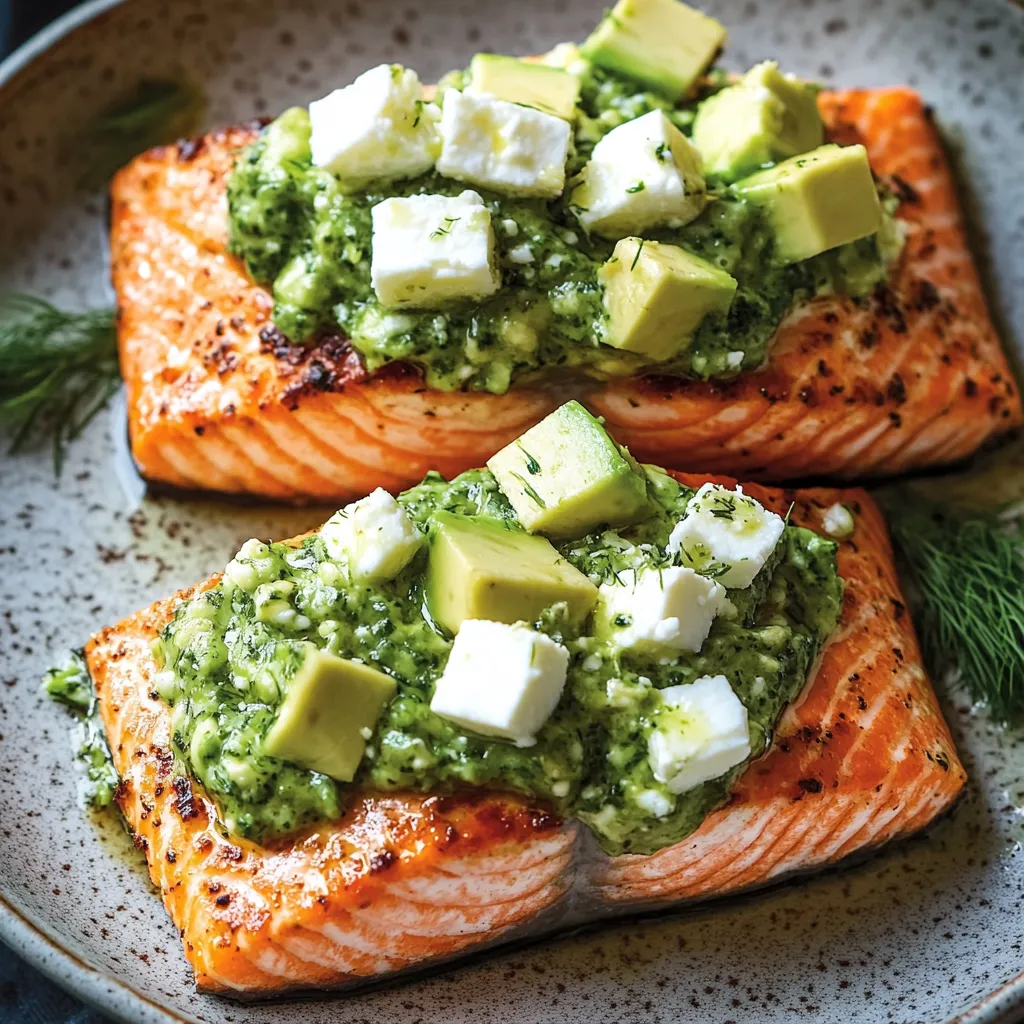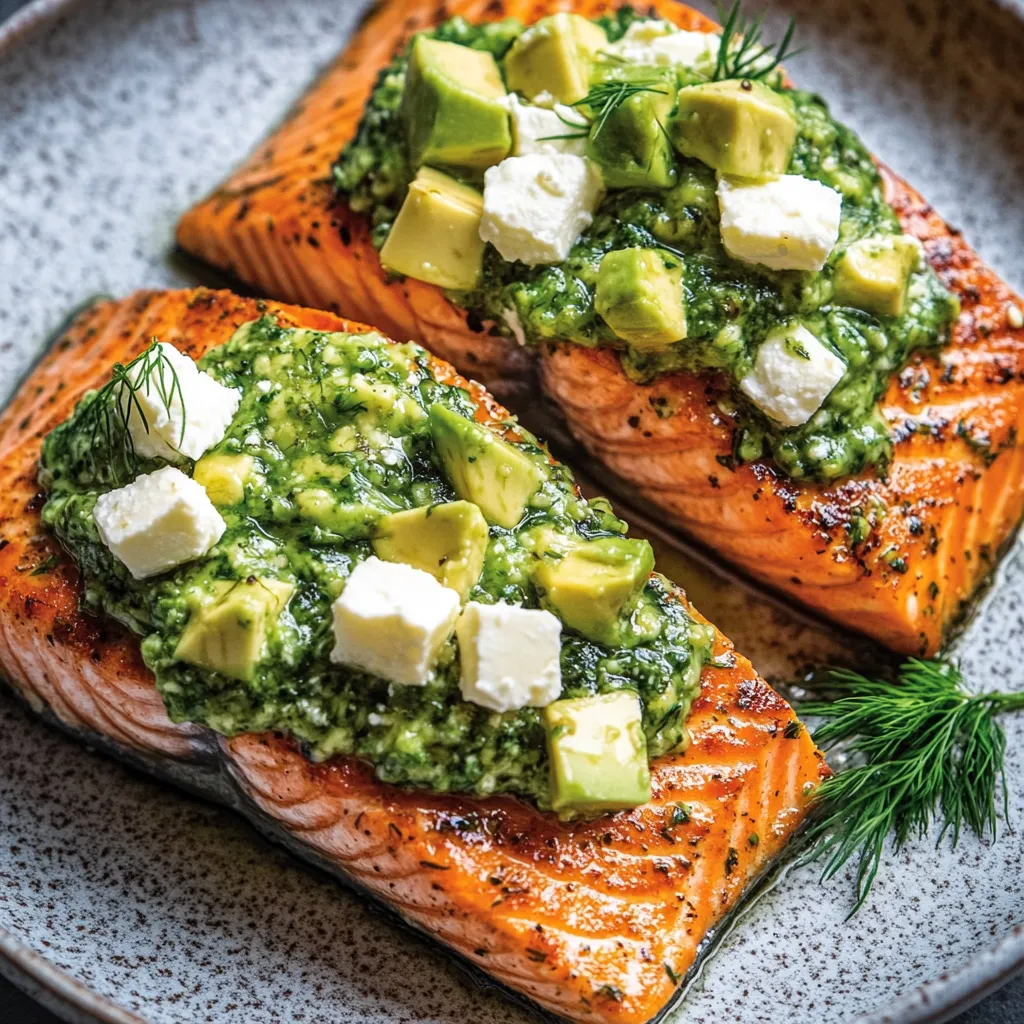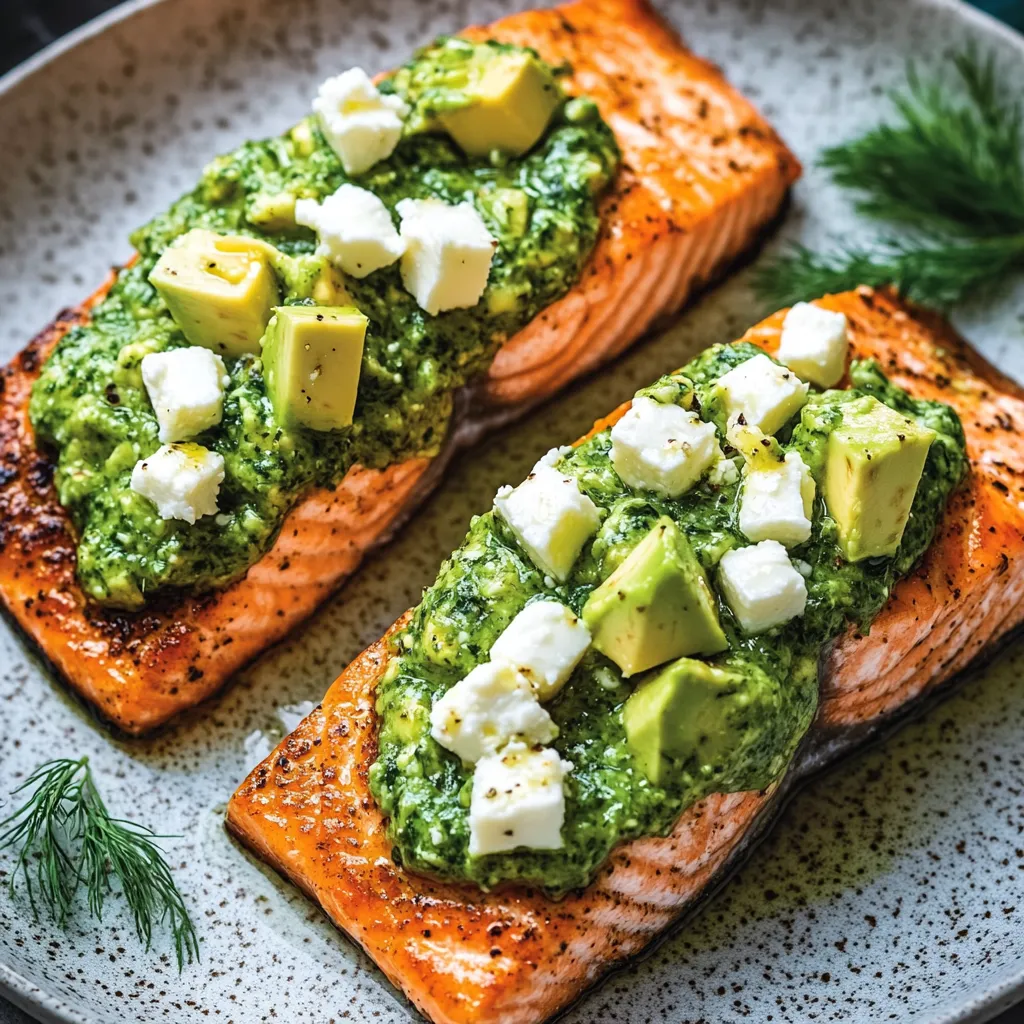 Pin it
Pin it
The gentle sizzle of salmon fillets in the oven fills my kitchen with a promise of the Mediterranean. After years of searching for weeknight meals that feel special without requiring hours of preparation, this dish has become my reliable hero. What makes it extraordinary isn't just the perfect contrast between warm, flaky salmon and cool, creamy avocado-feta topping, but how these simple ingredients transform into something that tastes like it came from a high-end restaurant. The bright lemon, fresh herbs, and savory feta create layers of flavor that belie the minimal effort required to create this impressive meal.
Last week I served this to my friend who claimed she "doesn't like fish" - she not only asked for seconds but requested the recipe before leaving. The combination of flavors won over even the most dedicated fish skeptic at my table!
Essential Elements
- Quality Salmon Fillets: The foundation of this dish
- Ripe Avocados: Provides creamy texture and healthy fats
- Authentic Feta Cheese: Adds salty depth and tanginess
- Fresh Herbs: Brightens with aromatic notes
- Lemons: Balances richness with acidity
- Light Olive Oil: Keeps salmon moist during baking
- Seasonings: Enhances natural flavors without overwhelming
Creating Salmon Magic
This recipe follows the culinary principle of contrasting temperatures and textures to create a memorable dining experience. The magic happens when the warm, perfectly baked salmon meets the cool, creamy avocado-feta mixture, creating a harmony of flavors and sensations that elevate this dish beyond a simple weeknight meal. The technique is simple but the results are truly extraordinary.
- Prepare Your Canvas:
- Pat salmon fillets completely dry for proper browning
- Bring salmon to room temperature for even cooking
- Line baking sheet with parchment for easy cleanup
- Position oven rack in center position for even heat
- Season with Precision:
- Brush salmon with olive oil and lemon mixture
- Season generously but thoughtfully with salt and pepper
- Add paprika for subtle warmth and color
- Apply seasonings evenly across each fillet
- Master the Cooking Process:
- Bake in preheated oven until just flaky
- Resist the urge to overcook – salmon continues cooking after removal
- Look for slight translucence in the center
- Test gently with a fork for perfect flakiness
- Create the Perfect Topping:
- Combine avocado and feta while salmon bakes
- Add fresh herbs just before serving for maximum aroma
- Balance with lemon juice and zest for brightness
- Season carefully, as feta brings saltiness
 Pin it
Pin it
Kitchen Equipment Essentials
Creating this impressive dish requires surprisingly minimal equipment, making it perfect for both novice cooks and well-equipped kitchens.
- Baking sheet: A rimmed pan prevents any juices from spilling
- Parchment paper: Creates easy release and simple cleanup
- Small mixing bowl: For preparing the avocado-feta topping
- Sharp knife: Essential for properly cutting herbs and avocado
A pastry brush helps distribute the olive oil and lemon mixture evenly across the salmon, ensuring perfect flavor in every bite. I keep a microplane grater dedicated to zesting citrus – it makes a noticeable difference in releasing the aromatic oils from the lemon peel. While not strictly necessary, an instant-read thermometer takes the guesswork out of determining when salmon is perfectly cooked (aim for 125°F for medium).
Make It Your Own
This versatile recipe welcomes creative adaptations based on your preferences and what's available in your kitchen.
Mediterranean variations:
- Add chopped kalamata olives to the topping
- Include sun-dried tomatoes for sweet intensity
- Sprinkle with toasted pine nuts for textural contrast
Herb alternatives:
- Substitute basil and mint for a summer variation
- Try cilantro and lime instead of dill and lemon
- Add fresh oregano for an authentic Greek flavor
Consider trying different cheeses if feta isn't your favorite – goat cheese creates a creamier topping, while crumbled blue cheese offers a more robust flavor profile. For additional texture, top with toasted bread crumbs or crushed pistachios just before serving. The basic technique remains the same regardless of which variation you choose – just keep the balance of creamy, salty, and bright flavors intact for the best results.
Storage Solutions
This dish shines brightest when served fresh, but leftovers can be managed with care. Store salmon and avocado-feta topping separately in airtight containers in the refrigerator for up to two days. Reheat salmon gently in a 275°F oven just until warmed through to prevent drying out. The topping will oxidize over time, but adding extra lemon juice helps maintain its color and freshness. Cold leftover salmon also makes an excellent addition to salads or grain bowls the next day, topped with a fresh batch of the avocado-feta mixture.
Perfect Pairings
This versatile salmon works beautifully with several complementary sides. For a complete meal, serve alongside fluffy rice pilaf or roasted baby potatoes to absorb the flavorful juices. Fresh green vegetables like asparagus, green beans, or a simple side salad provide color and balance to the rich salmon. For entertaining, start with a light soup like cucumber-yogurt or lemon-orzo before serving the salmon as your main course. A chilled glass of Sauvignon Blanc or Pinot Grigio complements the flavors perfectly, while sparkling water with lemon offers a refreshing non-alcoholic alternative.
Troubleshooting Tips
If your salmon turns out dry, you've likely overcooked it – next time, reduce cooking time by 1-2 minutes per half-inch thickness. For avocados that brown too quickly, increase the lemon juice in the topping and prepare it just before serving. Should your feta overpower the other flavors, reduce the amount or rinse it briefly before crumbling to remove excess saltiness. If the salmon sticks to the pan, ensure you're using parchment paper or adequately oiling the surface before baking. Remember that different salmon varieties (Atlantic, Sockeye, Coho) have varying fat contents and may require slight cooking time adjustments.
My Mediterranean grandmother, who believed fish should always be treated simply to honor its natural flavor, would approve of this preparation. Though her methods were more traditional, she taught me that quality ingredients need minimal intervention to shine. This recipe honors her wisdom by allowing each component to maintain its integrity while creating something greater than the sum of its parts.
 Pin it
Pin it
Conclusion
Baked Salmon with Avocado and Feta exemplifies how simple ingredients, thoughtfully combined, can create extraordinary meals with minimal effort. It transforms everyday dinner into something memorable while still respecting the busy lives we lead. Whether you're cooking for yourself after a long day, preparing a quick family dinner, or hosting friends for an impromptu gathering, this recipe delivers sophisticated flavors without complicated techniques. As you place that creamy avocado-feta topping on perfectly baked salmon, remember that great cooking often comes from confidence in simplicity rather than complexity of preparation.
Frequently Asked Questions
- → Can I use salmon with skin for this recipe?
- Yes! You can use salmon with skin - just place it skin-side down in the baking dish. The skin helps protect the salmon and adds flavor, though you can remove it before eating if preferred.
- → How do I know when the salmon is done?
- Salmon is done when it flakes easily with a fork and the inside is opaque. For medium doneness, the center should be slightly translucent. A meat thermometer should read 125°F for medium or 145°F for well-done.
- → Can I make the avocado-feta topping ahead of time?
- You can prepare it up to 2 hours ahead and refrigerate. The lemon juice helps prevent browning, but for best results, don't make it too far in advance as avocado will eventually oxidize.
- → What can I serve with this salmon dish?
- This pairs beautifully with roasted asparagus, a simple green salad, cauliflower rice, or quinoa. For a heartier meal, add some roasted potatoes or a slice of crusty bread.
- → Can I use dried herbs instead of fresh?
- Yes, though the flavor won't be as vibrant. Use 1 teaspoon dried dill instead of 1 tablespoon fresh, and dried chives can replace fresh at a 1:3 ratio. Fresh herbs really make this dish special if you can get them.
